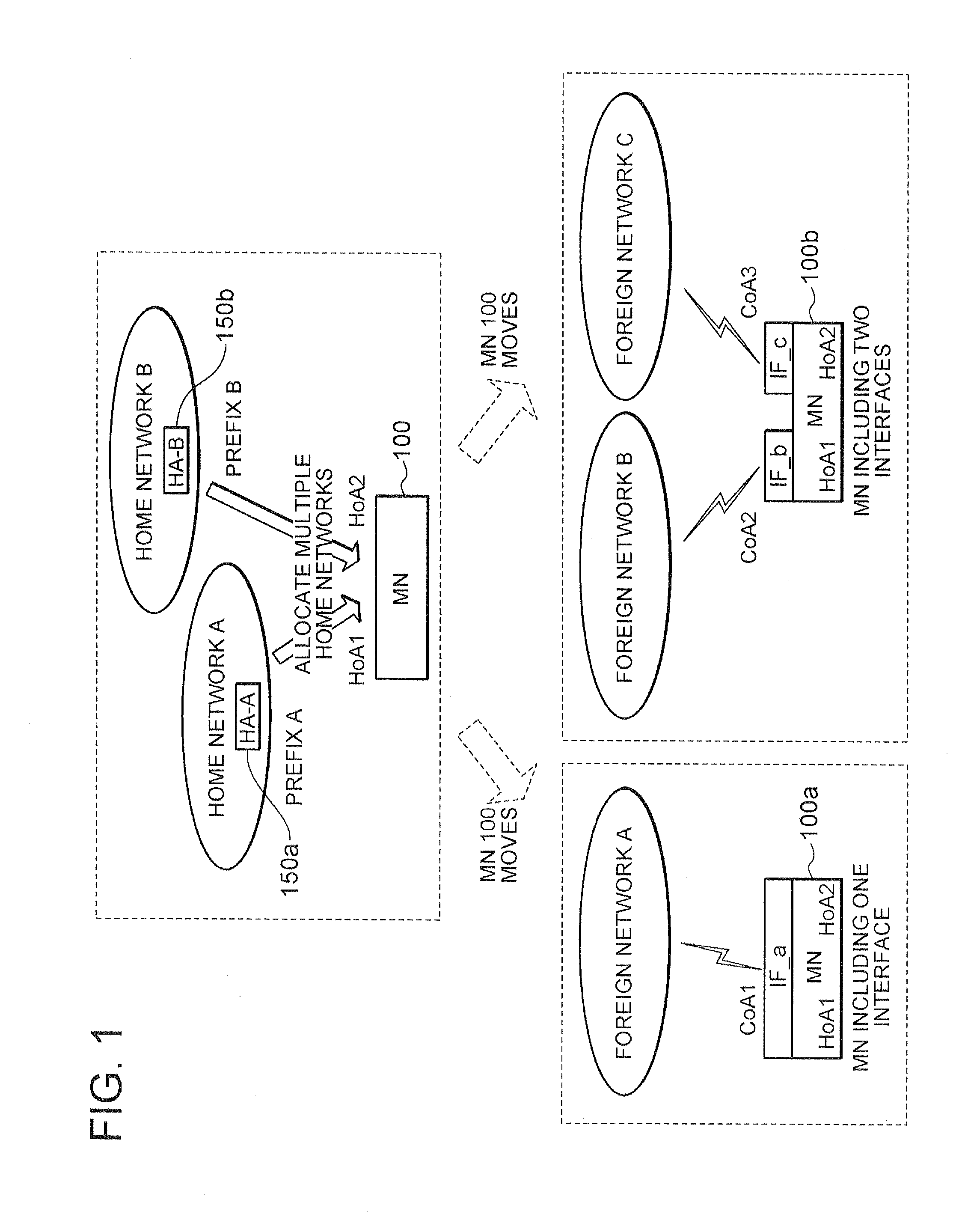Communication Node and Communication Control Method
a communication control and communication node technology, applied in the field of communication node and communication control method, can solve the problems of delay and packet loss, multi-homing controller cannot recognize, and the address the multi-homing controller has selected as a source address no longer accurately indicates the current location of the mn,
- Summary
- Abstract
- Description
- Claims
- Application Information
AI Technical Summary
Benefits of technology
Problems solved by technology
Method used
Image
Examples
first embodiment
[0205]The first embodiment of the present invention will now be described. FIG. 2 is a schematic diagram showing the internal arrangement of an MN to explain the overview of the first embodiment of the invention.
[0206]An MIP controller 120 and a multihoming controller 130 mounted in an MN are shown in FIG. 2. It should be noted that the presence of the MIP controller 120 indicates that a protocol, such as an MIP that achieves mobility management, is mounted in the MN, and the presence of the multihoming controller 130 indicates that a protocol that achieves multihoming is mounted in the MN.
[0207]The MIP controller 120 according to the first embodiment of the invention includes a mobility condition determination unit 126. The mobility condition determination unit 126 includes a function that obtains and examines various conditions (hereinafter called mobility conditions) that occur as the MN moves, and that, based on this mobility condition, determines the most appropriate set of an ...
second embodiment
[0283]Next, the second embodiment of the present invention will be described. FIG. 11 is a schematic diagram showing the internal arrangement of an MN to explain the overview of the second embodiment of the invention.
[0284]An MIP controller 220 and a multihoming controller 230 mounted in an MN are shown in FIG. 11. It should be noted that, as well as in FIG. 2, the presence of the MIP controller 220 indicates that a protocol, such as an MIP that achieves mobility management, is mounted in the MN, and the presence of the multihoming controller 230 indicates that a protocol that achieves multihoming is mounted in the MN.
[0285]The MIP controller 220 according to the second embodiment of the invention includes a mobility condition determination unit 226. The mobility condition determination unit 226 includes a function that obtains and examines a mobility condition, and based on this mobility condition, determines the most appropriate set of an HoA and a CoA for the current connection s...
third embodiment
[0298]Next, the third embodiment of the present invention will be described. FIG. 13 is a schematic diagram showing the internal arrangement of an MN to explain the overview of the third embodiment of the invention.
[0299]An MIP controller 320 and a multihoming controller 330 mounted in an MN are shown in FIG. 13. It should be noted that, as well as in FIG. 2, the presence of the MIP controller 320 indicates that a protocol, such as an MIP that achieves mobility management, is mounted in the MN, and the presence of the multihoming controller 330 indicates that a protocol that achieves multihoming is mounted in the MN.
[0300]The MIP controller 320 according to the third embodiment of the invention includes a mobility condition notification unit 327. The mobility condition notification unit 327 includes a function for transmitting, to the multihoming controller 330, a mobility condition available for the MIP controller 320.
[0301]Assume that, for example, the MN is in the multihomed stat...
PUM
 Login to View More
Login to View More Abstract
Description
Claims
Application Information
 Login to View More
Login to View More - R&D
- Intellectual Property
- Life Sciences
- Materials
- Tech Scout
- Unparalleled Data Quality
- Higher Quality Content
- 60% Fewer Hallucinations
Browse by: Latest US Patents, China's latest patents, Technical Efficacy Thesaurus, Application Domain, Technology Topic, Popular Technical Reports.
© 2025 PatSnap. All rights reserved.Legal|Privacy policy|Modern Slavery Act Transparency Statement|Sitemap|About US| Contact US: help@patsnap.com



